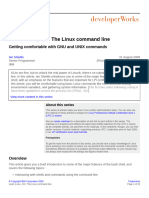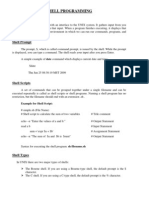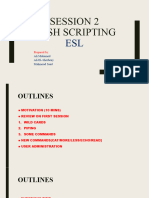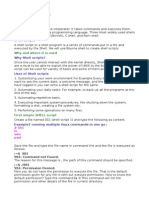0 ratings0% found this document useful (0 votes)
20 viewsTechskills Linuxshellscriptingbasics 6 2 2 Userinput Options
This document discusses using getopt and getopts to parse command line options in shell scripts. It explains that getopt groups options together and uses colons to specify options that require arguments. Getopts is more powerful than getopt in that it can handle options in any order and defines them in a similar way to getopt using colons. Getopts iterates through options using a while loop and places them in a variable, employing the $OPTARG and $OPTIND environmental variables to track option values and parameters. Standardizing options helps improve the user experience.
Uploaded by
Angelo GamoCopyright
© © All Rights Reserved
We take content rights seriously. If you suspect this is your content, claim it here.
Available Formats
Download as PDF, TXT or read online on Scribd
0 ratings0% found this document useful (0 votes)
20 viewsTechskills Linuxshellscriptingbasics 6 2 2 Userinput Options
This document discusses using getopt and getopts to parse command line options in shell scripts. It explains that getopt groups options together and uses colons to specify options that require arguments. Getopts is more powerful than getopt in that it can handle options in any order and defines them in a similar way to getopt using colons. Getopts iterates through options using a while loop and places them in a variable, employing the $OPTARG and $OPTIND environmental variables to track option values and parameters. Standardizing options helps improve the user experience.
Uploaded by
Angelo GamoCopyright
© © All Rights Reserved
We take content rights seriously. If you suspect this is your content, claim it here.
Available Formats
Download as PDF, TXT or read online on Scribd
You are on page 1/ 1
Filename:techskills-linuxshellscriptingbasics-6-2-2-userinput-options.
md
Show Name: Linux Shell Scripting Basics**
Topic Name: User Input
Episode Name: User Input: Options Pt.2
Description: In this episode, Daniel and Justin continue looking at
passing options to a shell script from the runline. Here they show you
how to employ getopt and getopts for expanding option functionality.
They also briefly discuss option standardization for better ease-of-use.
Keywords: [keyword1,keyword2,keyword3]
User Input: Options Pt.2
Using the getopt command
Group options together
command.sh -xyz
Format
getopt xyz
getopt x:yz
the colon tells getopt to expect a value
Getting your script to use getopt output
Use the set command
set -- $(getopt x:yz "$@")
This changes the way that the command-line options are being
interpreted.
set is telling the script to take $1 and TRANSLATE it through
getopt xyz or however it is stated
EXAMPLE: cli_options_getopt.sh -x +%Y%M%D -yz parm1 parm2 parm3
Maybe change this script in-show to be more simple, to use -xyz
Advancing to getopts
SINGULAR getopt doesn't recognize even with quotes
EXAMPLE: cli_options_getopt.sh -yz "test parm1" parm2 parm3
The first parameter should be "test parm1"
Never fear! getopts (PLURAL) is here!
Is a bit more powerful than getopt
It can handle
Sequentially iterates through the options using a while loop
Every time getopts runs it grabs the next option
The while loop does that well :)
Defines options much like getopt
x:yz
:x:yz Starting with a colon suppresses errors
Options are then placed into a variable
getopts :x:yz var1
Look at example
EXAMPLE: vim cli_options_getopts.sh
Employs 2 environmental variables
$OPTARG
Used if option Value is used
$OPTIND
Where getopts tracks the Parameters
Removes leading dashes
No need for dashes in the case function
-x) becomes x)
Any unknown option becomes a ?
Standardizing Options
You can make any options you like, BUT...
Standardizing the options you do use helps improve user experience
Let's look at some standard options
standard_options.txt
You might also like
- Bot Developers Have Logged Into Control Room With Their Bot Creator Account To Build BotsNo ratings yetBot Developers Have Logged Into Control Room With Their Bot Creator Account To Build Bots14 pages
- Ironstream Configuration and Users Guide v2.1No ratings yetIronstream Configuration and Users Guide v2.110 pages
- Vi Editor Common VI Editor Command List: For This Purpose Use This VI Command SyntaxNo ratings yetVi Editor Common VI Editor Command List: For This Purpose Use This VI Command Syntax29 pages
- Instant Access to Learning the bash Shell Unix Shell Programming Third Edition Cameron Newham ebook Full Chapters100% (1)Instant Access to Learning the bash Shell Unix Shell Programming Third Edition Cameron Newham ebook Full Chapters67 pages
- The Linux Command Line Gettingcomfortablewith GNU and UNIX CommandsNo ratings yetThe Linux Command Line Gettingcomfortablewith GNU and UNIX Commands23 pages
- 01_2018-04-12_bwHPC_course_-_Adv_Bash_ScriptingNo ratings yet01_2018-04-12_bwHPC_course_-_Adv_Bash_Scripting39 pages
- Learning the bash Shell Unix Shell Programming Third Edition Cameron Newham - Download the ebook now to never miss important content100% (1)Learning the bash Shell Unix Shell Programming Third Edition Cameron Newham - Download the ebook now to never miss important content47 pages
- Basics of UNIX Shells (Bourne Shell, Korn Shell, C Shell)No ratings yetBasics of UNIX Shells (Bourne Shell, Korn Shell, C Shell)64 pages
- bash Cookbook Solutions and Examples for bash Users Carl Albing - Download the ebook today and own the complete content100% (3)bash Cookbook Solutions and Examples for bash Users Carl Albing - Download the ebook today and own the complete content62 pages
- FALLSEM2019-20 CSE2005 ELA VL2019201002569 Reference Material I 25-Jul-2019 Shell ProgrammingNo ratings yetFALLSEM2019-20 CSE2005 ELA VL2019201002569 Reference Material I 25-Jul-2019 Shell Programming27 pages
- The UNIX Shells (Bourne Shell, Korn Shell, C Shell)No ratings yetThe UNIX Shells (Bourne Shell, Korn Shell, C Shell)64 pages
- Part 1 Linux Chapter 5 Shell ProgrammingNo ratings yetPart 1 Linux Chapter 5 Shell Programming25 pages
- The UNIX Shells (Bourne Shell, Korn Shell, C Shell)No ratings yetThe UNIX Shells (Bourne Shell, Korn Shell, C Shell)61 pages
- (Ebook) Linux Shell Scripting Bootcamp by James Kent Lewis ISBN 9781787281103, 1787281108 - The special ebook edition is available for download now100% (3)(Ebook) Linux Shell Scripting Bootcamp by James Kent Lewis ISBN 9781787281103, 1787281108 - The special ebook edition is available for download now85 pages
- Python Advanced Programming: The Guide to Learn Python Programming. Reference with Exercises and Samples About Dynamical Programming, Multithreading, Multiprocessing, Debugging, Testing and MoreFrom EverandPython Advanced Programming: The Guide to Learn Python Programming. Reference with Exercises and Samples About Dynamical Programming, Multithreading, Multiprocessing, Debugging, Testing and MoreNo ratings yet
- AN00263 Generic Drive Interface Using Siemens S7 PLCs Via Profinet Rev E enNo ratings yetAN00263 Generic Drive Interface Using Siemens S7 PLCs Via Profinet Rev E en31 pages
- Anti Theft System For Valuable Items Using LDRNo ratings yetAnti Theft System For Valuable Items Using LDR6 pages
- Course Syllabus 2019 IT Application Tools in Business75% (4)Course Syllabus 2019 IT Application Tools in Business11 pages
- Sat - 22.Pdf - Air Pollution Monitoring System Using IotNo ratings yetSat - 22.Pdf - Air Pollution Monitoring System Using Iot11 pages
- Resolving Gaps in DataGuard Apply Using Incremental RMAN BackupNo ratings yetResolving Gaps in DataGuard Apply Using Incremental RMAN Backup6 pages
- tiaSYSUP1500 - 06 - DistributedIO - en - 28 31 01 2020No ratings yettiaSYSUP1500 - 06 - DistributedIO - en - 28 31 01 202034 pages
- Fusion Server+2288 H+V7+Rack+Server+DatasheetNo ratings yetFusion Server+2288 H+V7+Rack+Server+Datasheet4 pages























































































